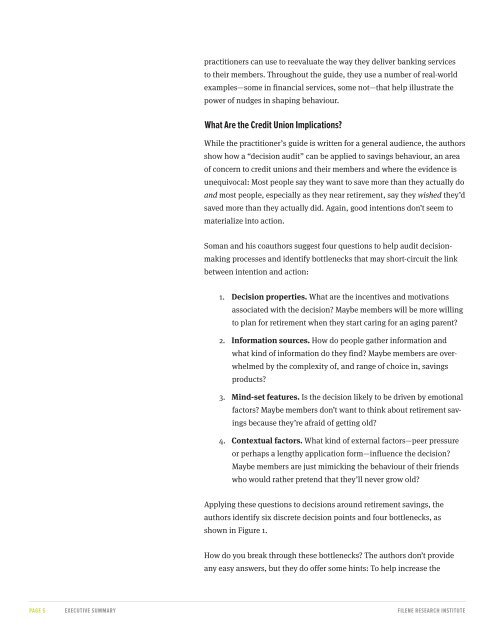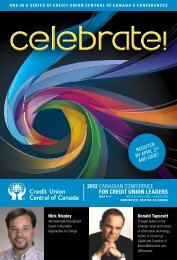A Practitioner’s Guide to Nudging
A Practitioner's Guide to Nudging - Credit Union Central of Canada
A Practitioner's Guide to Nudging - Credit Union Central of Canada
- No tags were found...
You also want an ePaper? Increase the reach of your titles
YUMPU automatically turns print PDFs into web optimized ePapers that Google loves.
practitioners can use <strong>to</strong> reevaluate the way they deliver banking services<br />
<strong>to</strong> their members. Throughout the guide, they use a number of real-world<br />
examples—some in financial services, some not—that help illustrate the<br />
power of nudges in shaping behaviour.<br />
What Are the Credit Union Implications?<br />
While the practitioner’s guide is written for a general audience, the authors<br />
show how a “decision audit” can be applied <strong>to</strong> savings behaviour, an area<br />
of concern <strong>to</strong> credit unions and their members and where the evidence is<br />
unequivocal: Most people say they want <strong>to</strong> save more than they actually do<br />
and most people, especially as they near retirement, say they wished they’d<br />
saved more than they actually did. Again, good intentions don’t seem <strong>to</strong><br />
materialize in<strong>to</strong> action.<br />
Soman and his coauthors suggest four questions <strong>to</strong> help audit decisionmaking<br />
processes and identify bottlenecks that may short-circuit the link<br />
between intention and action:<br />
1. Decision properties. What are the incentives and motivations<br />
associated with the decision? Maybe members will be more willing<br />
<strong>to</strong> plan for retirement when they start caring for an aging parent?<br />
2. Information sources. How do people gather information and<br />
what kind of information do they find? Maybe members are overwhelmed<br />
by the complexity of, and range of choice in, savings<br />
products?<br />
3. Mind-set features. Is the decision likely <strong>to</strong> be driven by emotional<br />
fac<strong>to</strong>rs? Maybe members don’t want <strong>to</strong> think about retirement savings<br />
because they’re afraid of getting old?<br />
4. Contextual fac<strong>to</strong>rs. What kind of external fac<strong>to</strong>rs—peer pressure<br />
or perhaps a lengthy application form—influence the decision?<br />
Maybe members are just mimicking the behaviour of their friends<br />
who would rather pretend that they’ll never grow old?<br />
Applying these questions <strong>to</strong> decisions around retirement savings, the<br />
authors identify six discrete decision points and four bottlenecks, as<br />
shown in Figure 1.<br />
How do you break through these bottlenecks? The authors don’t provide<br />
any easy answers, but they do offer some hints: To help increase the<br />
PAGE 5 EXECUTIVE SUMMARY FILENE RESEARCH INSTITUTE



